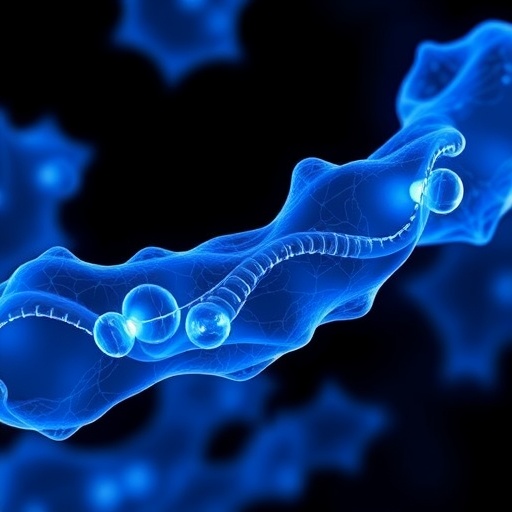In a groundbreaking development set to reshape the landscape of cancer biology, a team of researchers has unveiled pioneering insights into how the mechanical properties of adipose tissue influence the invasive behavior of ovarian cancer cells. Published in Nature Communications, this study leverages biomimetic organo-hydrogels to replicate the local mechanical anisotropy of human adipose tissue, illuminating a previously obscured dimension of tumor microenvironment dynamics. The implications of their findings extend far beyond ovarian cancer, potentially influencing future therapeutic strategies and biomaterial designs in oncology.
Emerging research in cancer progression has increasingly emphasized the role of the tumor microenvironment, the intricate matrix of cells and extracellular components enveloping a tumor. However, the precise mechanical cues within this milieu, particularly in the context of adipose tissue surrounding ovarian tumors, have remained enigmatic. By engineering organo-hydrogels that faithfully mimic the directional mechanical stiffness—or anisotropy—of adipose tissue, Gonzalez-Molina and colleagues provide a novel platform to dissect how cancer cells sense and respond to their physical surroundings.
The researchers began by decoding the mechanical signature of human adipose tissue harvested adjacent to ovarian tumors. Unlike isotropic materials whose properties are uniform in all directions, adipose tissue exhibits significant anisotropy due to the orientation of collagen fibers and lipid-rich cellular structures. This anisotropy manifests as directional variance in stiffness, which the team hypothesized could act as a migratory guidepost or barrier for invading cancer cells.
Central to the investigation was the fabrication of organo-hydrogels—hybrid constructs composed of both organic and inorganic components—that could replicate these mechanical disparities in vitro with unprecedented precision. By tuning the gel matrix’s fiber alignment and crosslink density, the team generated substrates exhibiting spatially varying stiffness that mirrored the complex anisotropic environment of native adipose tissue. This biomimicry allowed for systematic probing of cancer cell mechanics and invasion under conditions approximating those in vivo.
Upon seeding ovarian cancer cells onto these engineered hydrogels, striking patterns emerged. Cells exhibited preferential migration along the axis of greatest stiffness, demonstrating that directional mechanical cues actively steer invasive trajectories. This mechanotaxis was accompanied by enhanced cytoskeletal organization and focal adhesion assembly, signaling that cancer cells not only detected but transduced these physical stimuli into biochemical signals promoting motility.
Further investigation revealed that the anisotropic mechanical environment modulated gene expression profiles linked to aggressiveness and epithelial-to-mesenchymal transition (EMT), a process whereby epithelial cancer cells acquire mesenchymal phenotypes such as invasiveness and motility. This offers molecular evidence that biomechanical forces are integrally tied to the malignant progression pathway, strengthening the argument for incorporating mechanical parameters in cancer prognostic models.
One of the most compelling aspects of this study lies in its demonstration that disrupting anisotropic stiffness cues attenuates the invasive potential of ovarian cancer cells. By modulating the hydrogel stiffness to create isotropic or soft environments, the researchers effectively hampered directional invasion, suggesting possible pathways for therapeutic intervention that stiffen or alter the mechanical landscape to contain tumor spread.
The integration of biomimetic organo-hydrogels into cancer research represents a significant methodological advance. Traditional cell culture systems often rely on two-dimensional substrates with uniform mechanical properties, which fail to replicate the tridimensional and anisotropic realities of tissue. This system heralds an era where more physiologically relevant models provide deeper mechanistic insights and improved platforms for drug screening.
Beyond ovarian cancer, these findings provoke a reevaluation of how adipose tissue mechanics across various organs may influence tumor behavior. Given the widespread presence of adipose tissues and their known interactions with metastatic cells, understanding mechanical anisotropy could unlock clues into metastatic tropism and organ-specific tumor progression patterns.
This interdisciplinary work also bridges gaps between materials science and oncology, underscoring the potency of designing biomaterials that replicate not only biochemical but also biomechanical attributes of tissues. The tailored organo-hydrogels could be adapted to study other diseases where mechanical forces play pivotal roles, such as fibrosis or cardiovascular pathology.
Crucially, the study sheds light on the dynamic reciprocity between cancer cells and their microenvironment, emphasizing that malignancies are not merely aberrant cellular entities but are highly responsive to—and often exploit—physical cues. The adipose tissue’s anisotropy creates a form of “mechanical highway” that cancer cells navigate to invade and disseminate, highlighting new dimensions of tumor ecology ripe for exploitation.
Future therapeutic strategies might focus on altering the mechanical landscape to interrupt these highways. This could involve pharmacological agents targeting extracellular matrix remodeling enzymes or biomaterial implants that modify local stiffness profiles, providing new avenues for cancer containment.
Importantly, this research also opens discussions about patient-specific tumor microenvironments. Since adipose tissue mechanics may vary with individual physiology, personalized biomimetic models like these organo-hydrogels could predict invasion patterns or therapeutic resistance, ushering in precision oncology approaches that account for biomechanical heterogeneity.
In conclusion, Gonzalez-Molina et al. offer a transformative lens on ovarian cancer invasion through the innovation of biomimetic organo-hydrogels that faithfully reproduce adipose tissue’s local mechanical anisotropy. Their meticulous work elucidates the profound influence of directional stiffness on tumor dynamics, positioning mechanical cues at the forefront of cancer research paradigms. As these insights permeate clinical and experimental frameworks, they pave the way for novel diagnostic, prognostic, and therapeutic strategies rooted in the physics of cancer.
The convergence of biotechnology and materials science embodied in this study exemplifies how multidisciplinary collaborations yield breakthroughs with the potential to revolutionize our comprehension and treatment of complex diseases. The path ahead promises advancements not only in ovarian cancer management but across a spectrum of pathologies shaped by the intricate dialogue between cells and their mechanical microenvironments.
Subject of Research: The role of adipose tissue mechanical anisotropy in regulating ovarian cancer invasion using biomimetic organo-hydrogels.
Article Title: Biomimetic organo-hydrogels reveal the adipose tissue local mechanical anisotropy regulates ovarian cancer invasion.
Article References:
Gonzalez-Molina, J., Nabili, P., Marciano, D. et al. Biomimetic organo-hydrogels reveal the adipose tissue local mechanical anisotropy regulates ovarian cancer invasion. Nat Commun 16, 8541 (2025). https://doi.org/10.1038/s41467-025-62296-7
Image Credits: AI Generated
Tags: adipose tissue anisotropybiomimetic organo-hydrogelscancer cell mechanical sensingcancer progression researchcollagen fibers in adipose tissueextracellular matrix influence on tumorsinnovative biomaterials in medicinemechanical properties of adipose tissueNature Communications study on cancerovarian cancer cell invasiontherapeutic strategies in oncologytumor microenvironment dynamics





